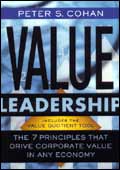|
|
|
Fabrica campus as designed
by Tadao Ando: Value-enhanced by Benetton's fashion ideas
|
|
|
What
this book's cover design lacks, in terms of whetting one's interest,
the 'genome' word and Mohanbir Sawhney's foreword make up for. To
Sawhney, this is about making the most of the information revolution
in general, and crashing interaction costs in particular-a phenomenon
that frees the constituent parts of business from the imposition
of collective functioning under a large corporate structure (seen
how email has lowered outsourcing costs?). To an observer of the
'punctuated equilibria' story of corporate evolution, this is about
the shift from vertical to virtual integration.
That sounds altogether too geeky. So it's to
the three A.T. Kearney authors' credit that this book packages the
argument neatly in terms of discrete business capabilities, the
'genes', that make up the corporate 'genome'. A capability, by the
way, is defined as "any set of value elements within the value
chain that make a unique contribution to output". Their basic
advice: think capabilities, focus on the most valuable genes, nurture
them, formulate strategies for each, and then look for opportunities
to recombine them creatively with other genes out there.
Isn't that-shudder, shudder-'atomisation'?
No, argue the authors, so long as it implies the deployment of strategy
at "lower levels of business aggregation". From conglomerates
to corporates to SBUs to capabilities, that's progress, and the
entertainment industry is already at its cutting edge.
|
|
|
Rebuilding The Corporate Genome
By Johan C. Aurik Gillis J. Jonk, Robert E. Willen
Wiley
PP: 314
Price: 1,488.52
|
The chapter
on strategy explains how all this builds on the concepts of C.K.
Prahalad's core competence and Michael Porter's competitiveness.
Freed of larger structural encumbrances, it's easier to optimise
the output of individual capabilities-since their optimisation drivers
differ.
So far, so theoretical. But wait, the story's
all in the examples. The globalised eyecare business now operates
with separate prescriptive and vanity-fulfilling capabilities. The
Coca-Cola Company has long hived off its bottling operations. Handspring
does little beyond applying its brains to customer needs, with all
the grunt work outsourced.
The real fun begins with genetic recombination.
And here, they say, the sum of parts will be greater than the whole
only "when companies grasp the tremendous opportunities emerging
from their individual capabilities". Examples? A unit of Philips
has joined forces with a part of Sara Lee to develop a hybrid percolator-espresso
machine that uses special beans to deliver a unique coffee experience
(the premium part of the value chain). Apparel player Benetton has
combined its ideas with those of paint maker Imagica to turn people's
walls fashionable.
The only jarring example-and perhaps the book's
weakest link-is the dreamt up 'what if' suggestion of separating
the oil industry's yield maximisation capability from oil-well operations
and exploration. The presumed benefit, of lower oil prices, is based
on assumptions of power leverage that are way too simplistic (just
as disaggregating other parts of this industry may lack practical
sense). A reassessment of intellectual capabilities would be a better
way to start.
The book also addresses the issue of value
migration-down the value chain. As an industry evolves, the authors
concede, the 'dominating gene' shifts from tech-specs to broader
aspects of consumer fulfillment. As any genetic engineer will tell
you, the consumer's mind is far more complex than anything business
has ever structured, and for this reason alone, value-generation
moves deeper into mindspace.
Amsterdam-based
Johan C. Aurik and
Boston-based Robert E. Willen (picture on the left), Vice-Presidents
at A.T. Kearney and two of the three co-authors of Rebuilding the
Corporate Genome, spoke to BT's Aresh
Shirali at the Taj Mansingh, Delhi, about the use of genetic
analogies in corporate theory. Excerpts:
Q: Given your book, where do you stand in the
'nurture' versus 'nature' debate?
In the nature-nurture debate, nature has been
winning, and we think that applies to our book. The genome is just
an analogy, of course, for corporations that are made up of building
blocks-genes if you like-that can be rearranged and reconfigured
into new animals. A gene is a capability, and in that sense, you
could argue that it's a 'nature' book. It's a 'nurture' book because
you can do something with it, for which we offer a framework with
tools.
Q. I couldn't help notice the emphasis on 'recombination'.
Is your book's central argument a case for companies to break themselves
up and recombine capabilities with other 'genes' to yield new companies?
Atomisation, the breakdown of businesses, is
seen as an irreversible trend. We don't agree. We think those pieces
can be put together in different ways to create competitive advantage.
So recombination is a very important theme. But that's just half
the story. You need to look at companies as a set of capabilities,
as Lego blocks, and look at these in their own right. See, A, how
you can recombine them in new original ways. And B, how each individual
capability can be optimised. So the other theme is focus.
Q. Do you see all this as a culmination of
'business Darwinism'?
Yeah. But Schumpeter, actually. Creative destruction.
This is accelerating. That's why executives need to look ahead.
 Value
Leadership Value
Leadership
By Peter S Cohan
Jossey-Bass
Price: Rs 920
PP: 312
Seven principles to enhance shareholder value: human relationships,
teamwork, frugal experimentation, commitment, anti-complacency,
multiple means and community sensitivity.
 Information
Feudalism Information
Feudalism
By Peter Drahos With John Braithwaite
Oxford University Press
Price: Rs 495
PP: 253
Who owns the Knowledge Economy? Arm yourself with this expose of
the feudal structure of the current intellectual property regime,
written just for India.
|
